Influence of Surface Layer Condition of Al2O3+TiC Ceramic Inserts on Quality of Deposited Coatings and Reliability during Hardened Steel Milling
Abstract
:1. Introduction
- (1)
- The mechanism of intragranular fracture of the CCT surface layer, according to which the external acting loads lead to the formation of microcracks of subcritical size in areas. The process is repeated many times, and it is the most favorable option from the point of view of the wear process and looks like a gradual abrasion of micro-sections on the CCT’s contact surfaces.
- (2)
- The mechanism of intergranular fracture with the separation of a single grain under the influence of a complex of thermal and force loads and the formation of unfavorable local areas in the CCT’s surface layer. A crack at the stable growth stage does not encounter obstacles during its development along the intergranular phase. The presence of multiple defects accelerates the development of a crack, and the critical growth stage begins with an almost instantaneous exit to the surface.
- (3)
- The mechanism of mixed destruction with separating a conglomerate of grains. This mechanism is the most unfavorable and unpredictable option for the CCT’s surface layer destruction. It is observed in the case of a critical combination of increased mechanical and thermal loads and numerous defects present in the volume and surface layer.
2. Materials and Methods
2.1. Cutting Tool, Processed Material and Reliability Assessment Methodology
2.2. Preparation of Cutting Ceramic Inserts with a Different Condition of the Surface Layer
2.3. Coating of Ceramic Inserts
2.4. Investigation of the Properties of the Surface Layer of Ceramic Inserts after Abrasive Treatment and Coating
3. Results and Discussion
3.1. Influence of Various Types of Abrasive Treatment on the Condition and Characteristics of the Surface Layer of Ceramic Inserts
3.2. Influence of the Condition of the Surface Layer of Ceramic Inserts on the Quality of the Formed Coatings
3.3. Influence of the Condition of the Surface Layer of Ceramic Inserts with Coatings on Reliability when Milling Hardened Steel
- (1)
- industrially produced Al2O3+TiC ceramic inserts subjected to diamond grinding at the final stage of manufacturing;
- (2)
- industrially produced Al2O3+TiC ceramic inserts subjected to diamond grinding and (TiZr)N coating with a thickness of ~3.7 µm;
- (3)
- industrially produced Al2O3+TiC ceramic inserts subjected to diamond grinding and additional lapping and polishing;
- (4)
- industrially produced Al2O3+TiC ceramic inserts subjected to diamond grinding and additional lapping and polishing and (TiZr)N coating with a thickness of ~3.7 µm.
4. Discussion
5. Conclusions
- (1)
- During the operation of industrially produced Al2O3+TiC ceramic inserts with the (TiZr)N coating in milling hardened steels of the 100CrMn type, an increase in the average resistance (Tav) by 1.4 times compared to the base-coated tool was noted. However, the coating does not solve the main problem of CCT of low reliability, since the tool resistance has a significant variation (VarT is 30%).
- (2)
- Minimizing the defectiveness of Al2O3+TiC ceramic inserts through the use of additional lapping and polishing increases the resistance to abrasive wear by two times and the crack resistance by ~6%. The coefficient of resistance variation, which characterizes the tool’s reliability, decreases by more than two times (VarT is 14%).
- (3)
- The use of “defect-free” Al2O3+TiC ceramic inserts with (TiZr)N coating demonstrates an increase in the average resistance (Tav) by 1.7 times compared to the ceramic inserts present on the market. The increase in average resistance is less significant and amounts to 1.2 times compared to ceramic inserts after diamond grinding and (TiZr)N coating.
- (4)
- The most important result of minimizing the degree of defectiveness is a considerable decrease in the range of change in the average resistance ΔT (by ~1.9 times) and the variation in the dispersion of resistance VarT up to 15%, which is two times less than that of ceramic inserts with (TiZr)N coating.
Author Contributions
Funding
Institutional Review Board Statement
Informed Consent Statement
Data Availability Statement
Acknowledgments
Conflicts of Interest
References
- Xing, Y.; Deng, J.; Zhao, J.; Zhang, G.; Zhang, K. Cutting performance and wear mechanism of nanoscale and microscale textured Al2O3/TiC ceramic tools in dry cutting of hardened steel. Int. J. Refract. Met. Hard Mater. 2014, 43, 46–58. [Google Scholar] [CrossRef]
- Lee, W.K.; Ratnam, M.M.; Ahmad, Z.A. In-process detection of chipping in ceramic cutting tools during turning of difficult-to-cut material using vision-based approach. Int. J. Adv. Manuf. Technol. 2016, 85, 1275–1290. [Google Scholar] [CrossRef]
- Benga, G.C.; Abrao, A.M. Turning of hardened 100Cr6 bearing steel with ceramic and PCBN cutting tools. J. Mater. Process. Technol. 2003, 143, 237–241. [Google Scholar] [CrossRef]
- Zhou, J.M.; Andersson, M.; Ståhl, J.E. Identification of cutting errors in precision hard turning process. J. Mater. Process. Technol. 2004, 153–154, 746–750. [Google Scholar] [CrossRef]
- Grzesik, W.; Rech, J.; Wanat, T. Surface finish on hardened bearing steel parts produced by superhard and abrasive tools. Int. J. Mach. Tools Manuf. 2007, 47, 255–262. [Google Scholar] [CrossRef]
- Brook, R.J. Concise Encyclopedia of Advanced Ceramic Materials, 1st ed.; Pergamon Press: Oxford, UK, 1991; p. 604. [Google Scholar] [CrossRef]
- Rizzo, A.; Goel, S.; Luisa Grilli, M.; Iglesias, R.; Jaworska, L.; Lapkovskis, V.; Novak, P.; Postolnyi, B.O.; Valerini, D. The Critical Raw Materials in Cutting Tools for Machining Applications: A Review. Materials 2020, 13, 1377. [Google Scholar] [CrossRef] [PubMed] [Green Version]
- Kuzin, V.V.; Grigor’ev, S.N.; Volosova, M.A. Effect of a TiC Coating on the Stress-Strain State of a Plate of a High-Density Nitride Ceramic Under Nonsteady Thermoelastic Conditions. Refract. Ind. Ceram. 2014, 54, 376–380. [Google Scholar] [CrossRef]
- Kuzin, V.V.; Grigor’ev, S.N.; Fedorov, S.Y. Evaluation of Ceramic Tool Reliability with a Limited Number of Tests Based on Established Wear Criteria. Refract. Ind. Ceram. 2018, 59, 386–390. [Google Scholar] [CrossRef]
- Grguras, D.; Kern, M.; Pusavec, F. Suitability of the full body ceramic end milling tools for high speed machining of nickel based alloy Inconel 718. Procedia CIRP 2018, 77, 630–633. [Google Scholar] [CrossRef]
- Jiang, C.P.; Wu, X.F.; Li, J.; Song, F.; Shao, Y.F.; Xu, X.H.; Yan, P. A study of the mechanism of formation and numerical simulations of crack patterns in ceramics subjected to thermal shock. Acta Mater. 2012, 60, 4540–4550. [Google Scholar] [CrossRef] [Green Version]
- Kuzin, V.V.; Grigoriev, S.N.; Volosova, M.A. The role of the thermal factor in the wear mechanism of ceramic tools: Part 1. Macrolevel. J. Frict. Wear 2014, 35, 505–510. [Google Scholar] [CrossRef]
- Kuzin, V.V.; Grigor’ev, S.N.; Volosova, M.A. Microstructural Model of the Surface Layer of Ceramics After Diamond Grinding Taking into Account Its Real Structure and the Conditions of Contact Interaction with Elastic Body. Refract. Ind. Ceram. 2020, 61, 303–308. [Google Scholar] [CrossRef]
- Vigneau, J.; Bordel, P.; Geslot, R. Reliability of ceramic cutting tools. CIRP Ann. 1988, 37, 101–104. [Google Scholar] [CrossRef]
- Vereschaka, A.A.; Batako, A.D.; Krapostin, A.A.; Sitnikov, N.N.; Oganyan, G.V. Improvement in Reliability of Ceramic Cutting Tool using a Damping System and Nano-structured Multi-layered Composite Coatings. Procedia CIRP 2017, 63, 563–568. [Google Scholar] [CrossRef]
- Wachtman, J.B.; Cannon, W.R.; Matthewson, M.J. Mechanical Properties of Ceramics, 2nd ed.; Wiley: Hoboken, NJ, USA, 2009; Volume XVI, p. 479. ISBN 978-0-471-73581-6. [Google Scholar]
- Vereschaka, A.; Tabakov, V.; Grigoriev, S.; Sitnikov, N.; Andreev, N.; Milovich, F. Investigation of wear and diffusion processes on rake faces of carbide inserts with Ti-TiN-(Ti,Al,Si)N composite nanostructured coating. Wear 2018, 416–417, 72–80. [Google Scholar] [CrossRef]
- Sobol, O.V.; Andreev, A.A.; Grigoriev, S.N.; Gorban, V.F.; Volosova, M.A.; Aleshin, S.V.; Stolbovoi, V.A. Effect of high-voltage pulses on the structure and properties of titanium nitride vacuum-arc coatings. Met. Sci. Heat Treat. 2012, 54, 195–203. [Google Scholar] [CrossRef]
- Vereschaka, A.A.; Grigoriev, S.N.; Sitnikov, N.N.; Oganyan, G.V.; Batako, A. Working efficiency of cutting tools with multilayer nano-structured Ti-TiCN-(Ti,Al)CN and Ti-TiCN-(Ti,Al,Cr)CN coatings: Analysis of cutting properties, wear mechanism and diffusion processes. Surf. Coat. Technol. 2017, 332, 198–213. [Google Scholar] [CrossRef]
- Long, Y.; Zeng, J.; Yu, D.; Wu, S. Microstructure of TiAlN and CrAlN coatings and cutting performance of coated silicon nitride inserts in cast iron turning. Ceram. Int. 2014, 40, 9889–9894. [Google Scholar] [CrossRef]
- Sobol, O.V.; Andreev, A.A.; Grigoriev, S.N.; Volosova, M.A.; Gorban, V.F. Vacuum-arc multilayer nanostructured TiN/Ti coatings: Structure, stress state, properties. Met. Sci. Heat Treat. 2012, 54, 28–33. [Google Scholar] [CrossRef]
- Volosova, M.; Grigoriev, S.; Metel, A.; Shein, A. The Role of Thin-Film Vacuum-Plasma Coatings and Their Influence on the Efficiency of Ceramic Cutting Inserts. Coatings 2018, 8, 287. [Google Scholar] [CrossRef] [Green Version]
- Wang, H.; Zhang, J.; Yi, M.; Xiao, G.; Chen, Z.; Sheng, C.; Zhang, P.; Xu, C. Simulation study on influence of coating thickness on cutting performance of coated ceramic cutting tools. J. Phys. Conf. Ser. 2020, 1549, 032140. [Google Scholar] [CrossRef]
- Grigoriev, S.N.; Vereschaka, A.A.; Fyodorov, S.V.; Sitnikov, N.N.; Batako, A.D. Comparative analysis of cutting properties and nature of wear of carbide cutting tools with multi-layered nano-structured and gradient coatings produced by using of various deposition methods. Int. J. Adv. Manuf. Technol. 2017, 90, 3421–3435. [Google Scholar] [CrossRef]
- Liu, W.; Chu, Q.; Zeng, J.; He, R.; Wu, H.; Wu, Z.; Wu, S. PVD-CrAlN and TiAlN coated Si3N4 ceramic cutting tools –1. Microstructure, turning performance and wear mechanism. Ceram. Int. 2017, 43, 8999–9004. [Google Scholar] [CrossRef]
- Long, Y.; Zeng, J.; Wu, S. Cutting performance and wear mechanism of Ti–Al–N/Al–Cr–O coated silicon nitride ceramic cutting inserts. Ceram. Int. 2014, 40, 9615–9620. [Google Scholar] [CrossRef]
- Vereschaka, A.A.; Volosova, M.A.; Grigoriev, S.N.; Vereschaka, A.S. Development of wear-resistant complex for high-speed steel tool when using process of combined cathodic vacuum arc deposition. Procedia CIRP 2013, 9, 8–12. [Google Scholar] [CrossRef] [Green Version]
- Das, S.R.; Dhupal, D.; Kumar, A. Experimental investigation into machinability of hardened AISI 4140 steel using TiN coated ceramic tool. Measurement 2015, 62, 108–126. [Google Scholar] [CrossRef]
- Aslantas, K.; Ucun, İ.; Çicek, A. Tool life and wear mechanism of coated and uncoated Al2O3/TiCN mixed ceramic tools in turning hardened alloy steel. Wear 2012, 274–275, 442–451. [Google Scholar] [CrossRef]
- Bensouilah, H.; Aouici, H.; Meddour, I.; Yallese, M.A.; Mabrouki, T.; Girardin, F. Performance of coated and uncoated mixed ceramic tools in hard turning process. Measurement 2016, 82, 1–18. [Google Scholar] [CrossRef]
- Dobranski, L.A.; Mikula, J. Structure and properties of PVD and CVD coated Al2O3+TiC mixed oxide tool ceramics for dry on high speed cutting processes. J. Mater. Process. Technol. 2005, 164–165, 822–831. [Google Scholar] [CrossRef]
- Kumar, C.S.; Patel, S.K. Experimental and numerical investigations on the effect of varying AlTiN coating thickness on hard machining performance of Al2O3-TiCN mixed ceramic inserts. Surf. Coat. Technol. 2017, 309, 266–281. [Google Scholar] [CrossRef]
- Souza, J.V.C.; Macedo, O.M.; Nono, M.C.A.; Machado, J.P.B.; Pimenta, M.; Ribeiro, M.V. Si3N4 ceramic cutting tool sintered with CeO2 and Al2O3 additives with AlCrN coating. Mat. Res. 2011, 14, 514–518. [Google Scholar] [CrossRef] [Green Version]
- Staszuk, M.; Pakuła, D.; Chladek, G.; Pawlyta, M.; Pancielejko, M.; Czaja, P. Investigation of the structure and properties of PVD coatings and ALD + PVD hybrid coatings deposited on sialon tool ceramics. Vacuum 2018, 154, 272–284. [Google Scholar] [CrossRef]
- Nairy, K.S.; Rao, K.A. Tests of coefficient of variation of normal population. Commun. Stat. Simul. Comput. 2003, 32, 641–661. [Google Scholar] [CrossRef]
- Grigoriev, S.N.; Teleshevskii, V.I. Measurement problems in technological shaping processes. Meas. Tech. 2011, 54, 744–749. [Google Scholar] [CrossRef]
- Albertelli, P.; Mussi, V.; Monno, M. Development of generalized tool life model for constant and variable speed turning. Int. J. Adv. Manuf. Technol. 2022, 118, 1885–1901. [Google Scholar] [CrossRef]
- Grigoriev, S.N.; Sinopalnikov, V.A.; Tereshin, M.V.; Gurin, V.D. Control of parameters of the cutting process on the basis of diagnostics of the machine tool and workpiece. Meas. Tech. 2012, 55, 555–558. [Google Scholar] [CrossRef]
- Broderick, M.; Turner, S.; Ridgway, K. Correlation between tool life and cutting force coefficient as the basis for a novel method in accelerated MWF performance assessment. Procedia CIRP 2021, 101, 366–369. [Google Scholar] [CrossRef]
- Grigoriev, S.N.; Gurin, V.D.; Volosova, M.A.; Cherkasova, N.Y. Development of residual cutting tool life prediction algorithm by processing on CNC machine tool. Materwiss. Werksttech. 2013, 44, 790–796. [Google Scholar] [CrossRef]
- Arai, S.A.; Wilson, S.A.; Corbett, J.; Whatmore, R.W. Ultra-precision grinding of PZT ceramics—Surface integrity control and tooling design. Int. J. Mach. Tools Manuf. 2009, 49, 998–1007. [Google Scholar] [CrossRef]
- Canneto, J.J.; Cattani-Lorente, M.; Durual, S.; Wiskott, A.H.W.; Scherrer, S.S. Grinding damage assessment on four high-strength ceramics. Dent. Mater. 2016, 32, 171–182. [Google Scholar] [CrossRef] [Green Version]
- Zhang, C.; Liu, H.; Zhao, Q.; Guo, B.; Wang, J.; Zhang, J. Mechanisms of ductile mode machining for AlON ceramics. Ceram. Int. 2020, 46, 1844–1853. [Google Scholar] [CrossRef]
- Grigoriev, S.N.; Metel, A.S.; Fedorov, S.V. Modification of the structure and properties of high-speed steel by combined vacuum-plasma treatment. Met. Sci. Heat Treat. 2012, 54, 12. [Google Scholar] [CrossRef]
- Metel, A.S.; Grigoriev, S.N.; Melnik, Y.A.; Bolbukov, V.P. Broad beam sources of fast molecules with segmented cold cathodes and emissive grids. Instrum. Exp. Tech. 2012, 55, 122–130. [Google Scholar] [CrossRef]
- Grigoriev, S.; Metel, A. Plasma- and Beam-Assisted Deposition Methods. In Nanostructured Thin Films and Nanodispersion Strengthened Coatings; NATO Science Series II: Mathematics, Physics and Chemistry; Voevodin, A.A., Shtansky, D.V., Levashov, E.A., Moore, J.J., Eds.; Springer: Berlin/Heidelberg, Germany, 2004; Volume 155, pp. 147–154. ISBN 9781402022227. [Google Scholar] [CrossRef]
- Metel, A.; Bolbukov, V.; Volosova, M.; Grigoriev, S.; Melnik, Y. Source of metal atoms and fast gas molecules for coating deposition on complex shaped dielectric products. Surf. Coat. Technol. 2013, 225, 34–39. [Google Scholar] [CrossRef]
- Grigoriev, S.N.; Melnik, Y.A.; Metel, A.S.; Panin, V.V.; Prudnikov, V.V. A compact vapor source of conductive target material sputtered by 3-keV ions at 0.05-Pa pressure. Instrum. Exp. Tech. 2009, 52, 731–737. [Google Scholar] [CrossRef]
- Pat, S.; Ekem, N.; Akan, T.; Küsmüs, Ö.; Demirkol, S.; Vladoiu, R.; Lungu, C.P.; Musa, G. Study on Termionic Vacuum Arc—A Novel and Advanced Technology for Surface Coating. J. Optoelectron. Adv. Mater. 2005, 7, 2495–2499. [Google Scholar]
- Vladoiu, R.; Tichý, M.; Mandes, A.; Dinca, V.; Kudrna, P. Thermionic Vacuum Arc—A Versatile Technology for Thin Film Deposition and Its Applications. Coatings 2020, 10, 211. [Google Scholar] [CrossRef] [Green Version]
- Vetter, J.; Eriksson, A.O.; Reiter, A.; Derflinger, V.; Kalss, W. Quo Vadis: AlCr-Based Coatings in Industrial Applications. Coatings 2021, 11, 344. [Google Scholar] [CrossRef]
- Zhang, Z.; Zhang, L.; Yuan, H.; Qiu, M.; Zhang, X.; Liao, B.; Zhang, F.; Ouyang, X. Tribological Behaviors of Super-Hard TiAlN Coatings Deposited by Filtered Cathode Vacuum Arc Deposition. Materials 2022, 15, 2236. [Google Scholar] [CrossRef]
- Metel, A.S.; Grigoriev, S.N.; Melnik, Y.A.; Prudnikov, V.V. Glow discharge with electrostatic confinement of electrons in a chamber bombarded by fast electrons. Plasma Phys. Rep. 2011, 37, 628–637. [Google Scholar] [CrossRef]
- Grigoriev, S.N.; Fominski, V.Y.; Gnedovets, A.G.; Romanov, R.I. Experimental and numerical study of the chemical composition of WSex thin films obtained by pulsed laser deposition in vacuum and in a buffer gas atmosphere. Appl. Surf. Sci. 2012, 258, 7000–7007. [Google Scholar] [CrossRef]
- Grigoriev, S.; Melnik, Y.; Metel, A. Broad fast neutral molecule beam sources for industrial scale beam-assisted deposition. Surf. Coat. Technol. 2002, 156, 44–49. [Google Scholar] [CrossRef]
- Metel, A.; Bolbukov, V.; Volosova, M.; Grigoriev, S.; Melnik, Y. Equipment for deposition of thin metallic films bombarded by fast argon atoms. Instrum. Exp. Tech. 2014, 57, 345–351. [Google Scholar] [CrossRef]
- Mei, Z.; Lu, Y.; Lou, Y.; Yu, P.; Sun, M.; Tan, X.; Zhang, J.; Yue, L.; Yu, H. Determination of Hardness and Fracture Toughness of Y-TZP Manufactured by Digital Light Processing through the Indentation Technique. Biomed. Res. Int. 2021, 2021, 6612840. [Google Scholar] [CrossRef]
- Franco Steier, V.; Ashiuchi, E.S.; Reißig, L.; Araújo, J.A. Effect of a Deep Cryogenic Treatment on Wear and Microstructure of a 6101 Aluminum Alloy. Adv. Mater. Sci. Eng. 2016, 2016, 1582490. [Google Scholar] [CrossRef] [Green Version]
- Shulepov, I.A.; Kashkarov, E.B.; Stepanov, I.B.; Syrtanov, M.S.; Sutygina, A.N.; Shanenkov, I.; Obrosov, A.; Weiß, S. The Formation of Composite Ti-Al-N Coatings Using Filtered Vacuum Arc Deposition with Separate Cathodes. Metals 2017, 7, 497. [Google Scholar] [CrossRef] [Green Version]
- Oliver, W.C.; Pharr, G.M. An improved technique for determining hardness and elastic modulus using load and displacement sensing indentation experiments. J. Mater. Res. 1992, 7, 1564–1583. [Google Scholar] [CrossRef]
- Kim, Y.S.; Park, H.J.; Lim, K.S.; Hong, S.H.; Kim, K.B. Structural and Mechanical Properties of AlCoCrNi High Entropy Nitride Films: Influence of Process Pressure. Coatings 2020, 10, 10. [Google Scholar] [CrossRef] [Green Version]
- Choudhary, R.K.; Mishra, P. Use of Acoustic Emission During Scratch Testing for Understanding Adhesion Behavior of Aluminum Nitride Coatings. J. Mater. Eng. Perform. 2016, 25, 2454–2461. [Google Scholar] [CrossRef]
- Grigoriev, S.N.; Kozochkin, M.P.; Sabirov, F.S.; Kutin, A.A. Diagnostic Systems as Basis for Technological Improvement. Procedia CIRP 2012, 1, 599–604. [Google Scholar] [CrossRef] [Green Version]
- Kazlauskas, D.; Jankauskas, V.; Tučkutė, S. Research on Tribological Characteristics of Hard Metal WC-Co Tools with TiAlN and CrN PVD Coatings for Processing Solid Oak Wood. Coatings 2020, 10, 632. [Google Scholar] [CrossRef]
- Wang, H.; Huang, Z.; Qi, J.; Wang, J. A new methodology to obtain the fracture toughness of YAG transparent ceramics. J. Adv. Ceram. 2019, 8, 418–426. [Google Scholar] [CrossRef] [Green Version]
- Muboyadzhyan, S.A.; Budinovskii, S.A.; Gorlov, D.S.; Doronin, O.N. Structure and Microporosity of Ion-Plasma Condensed Coatings Deposited from a Two-Phase Vacuum-Arc Discharge Plasma Flow Containing Evaporated Material Microdroplets. Russ. Metall. 2019, 2019, 52–62. [Google Scholar] [CrossRef]
- Ryabchikov, A.I.; Sivin, D.O.; Bumagina, A.I. Physical mechanisms of macroparticles number density decreasing on a substrate immersed in vacuum arc plasma at negative high-frequency short-pulsed biasing. Appl. Surf. Sci. 2014, 305, 487–491. [Google Scholar] [CrossRef]
- Sobol, O.V.; Pogrebnyak, A.D.; Beresnev, V.M. Effect of the preparation conditions on the phase composition, structure, and mechanical characteristics of vacuum-Arc Zr-Ti-Si-N coatings. Phys. Met. Metallogr. 2011, 112, 188. [Google Scholar] [CrossRef]
- Sveen, S.; Andersson, J.M.; M’Saoubi, R.; Olsson, M. Scratch adhesion characteristics of PVD TiAlN deposited on high speed steel, cemented carbide and PCBN substrates. Wear 2013, 308, 133–141. [Google Scholar] [CrossRef]
- Khlifi, K.; Ben Cheikh Larbi, A. Investigation of adhesion of PVD coatings using various approaches. Surf. Eng. 2013, 29, 555–560. [Google Scholar] [CrossRef]
- Dobrzański, L.A.; Żukowska, L.W. Gradient PVD coatings deposited on the sintered tool materials. Arch. Mater. Sci. Eng. 2011, 48, 103–111. [Google Scholar]
- Tillmann, W.; Stangier, D.; Denkena, B.; Grove, T.; Lucas, H. Influence of PVD-coating technology and pretreatments on residual stresses for sheet-bulk metal forming tools. Prod. Eng. Res. Devel. 2016, 10, 17–24. [Google Scholar] [CrossRef]
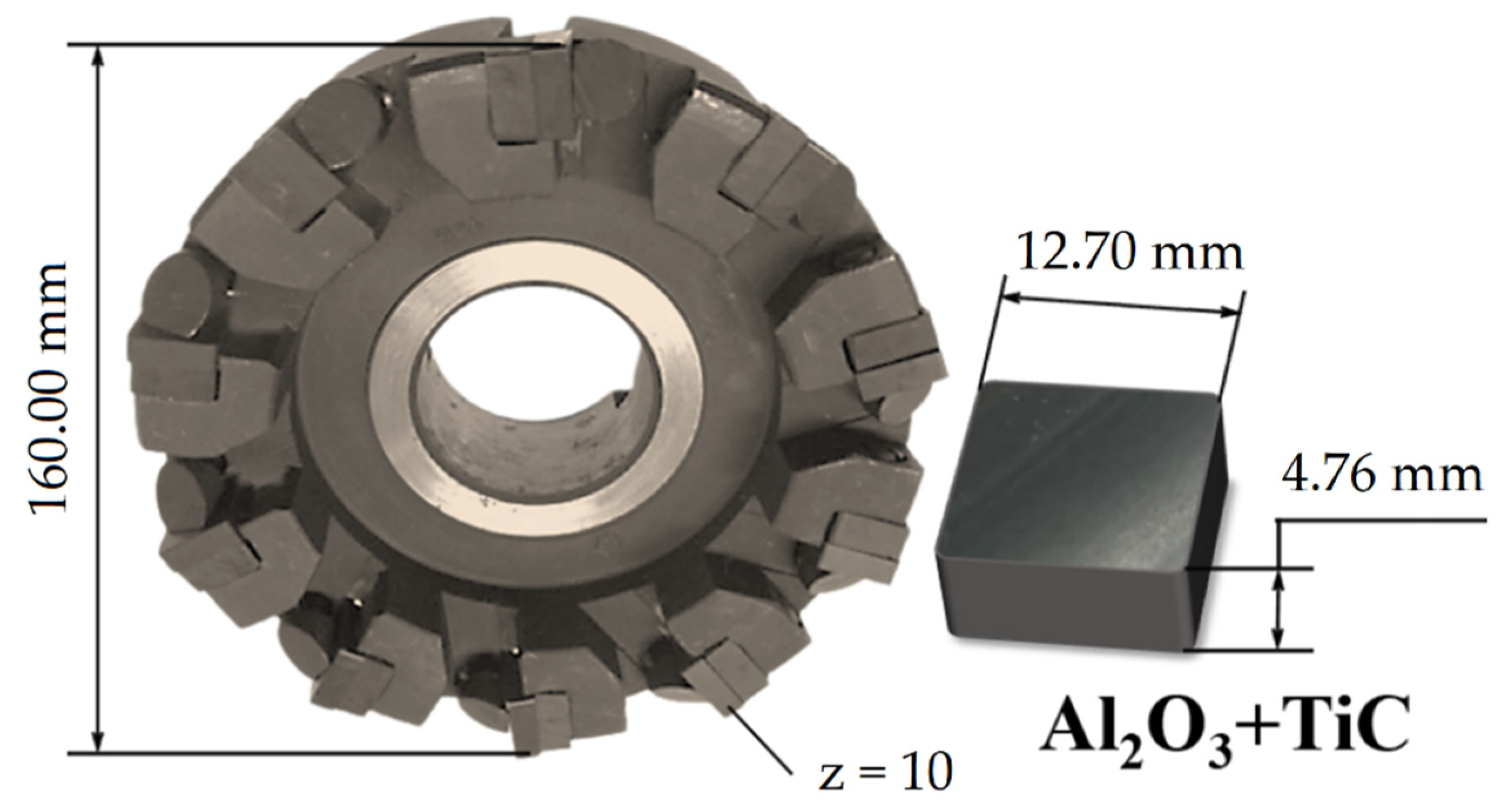
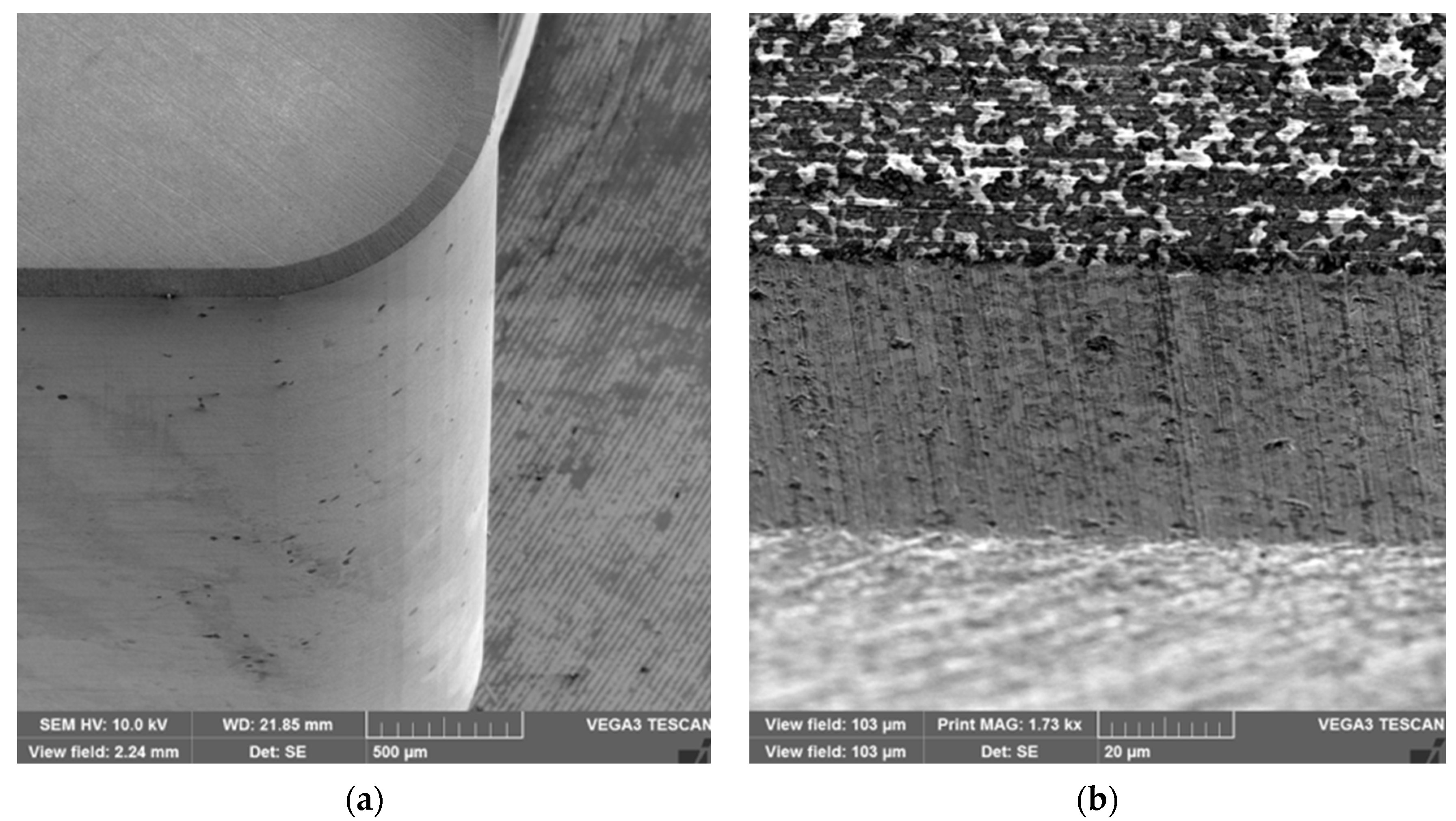
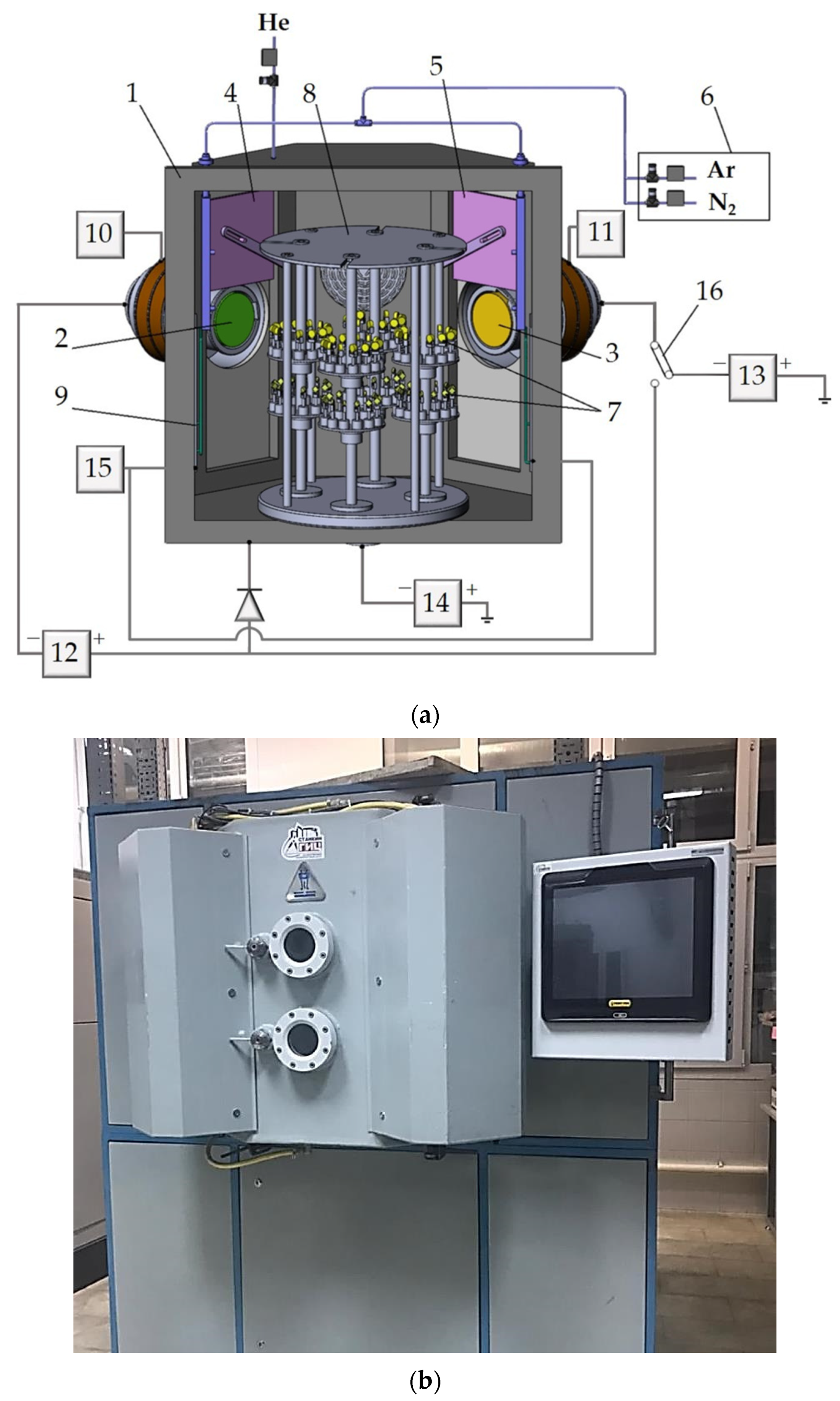



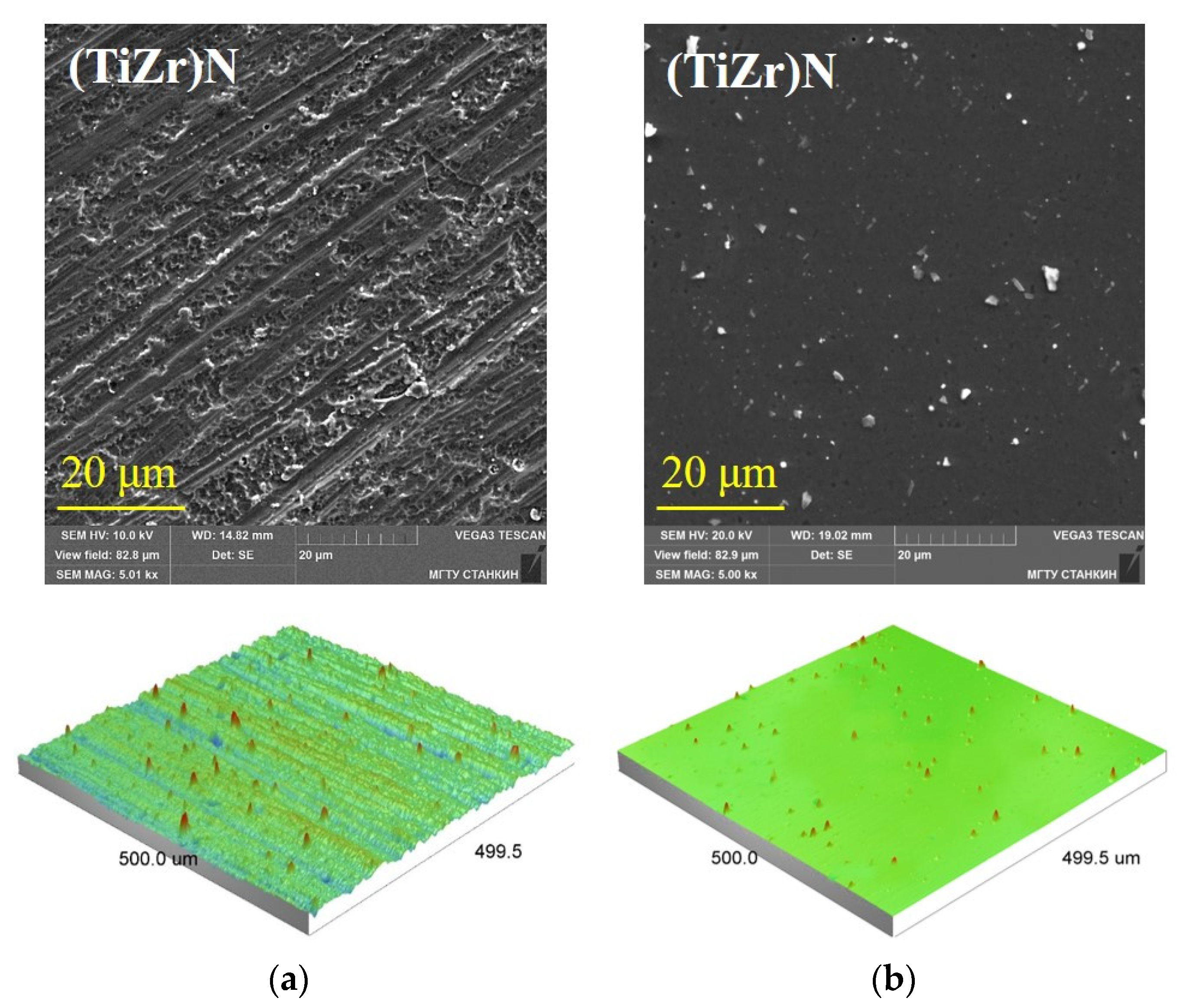
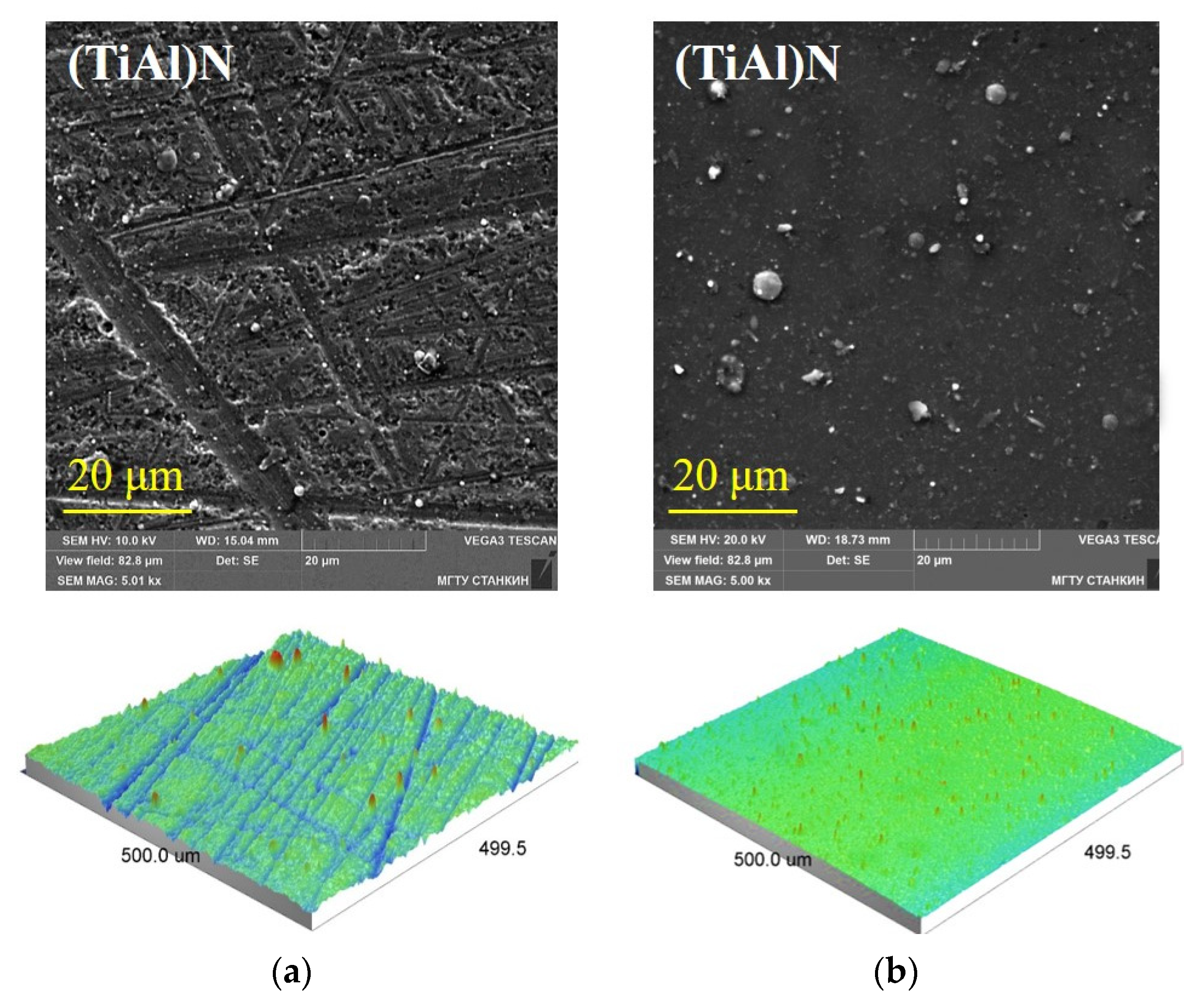
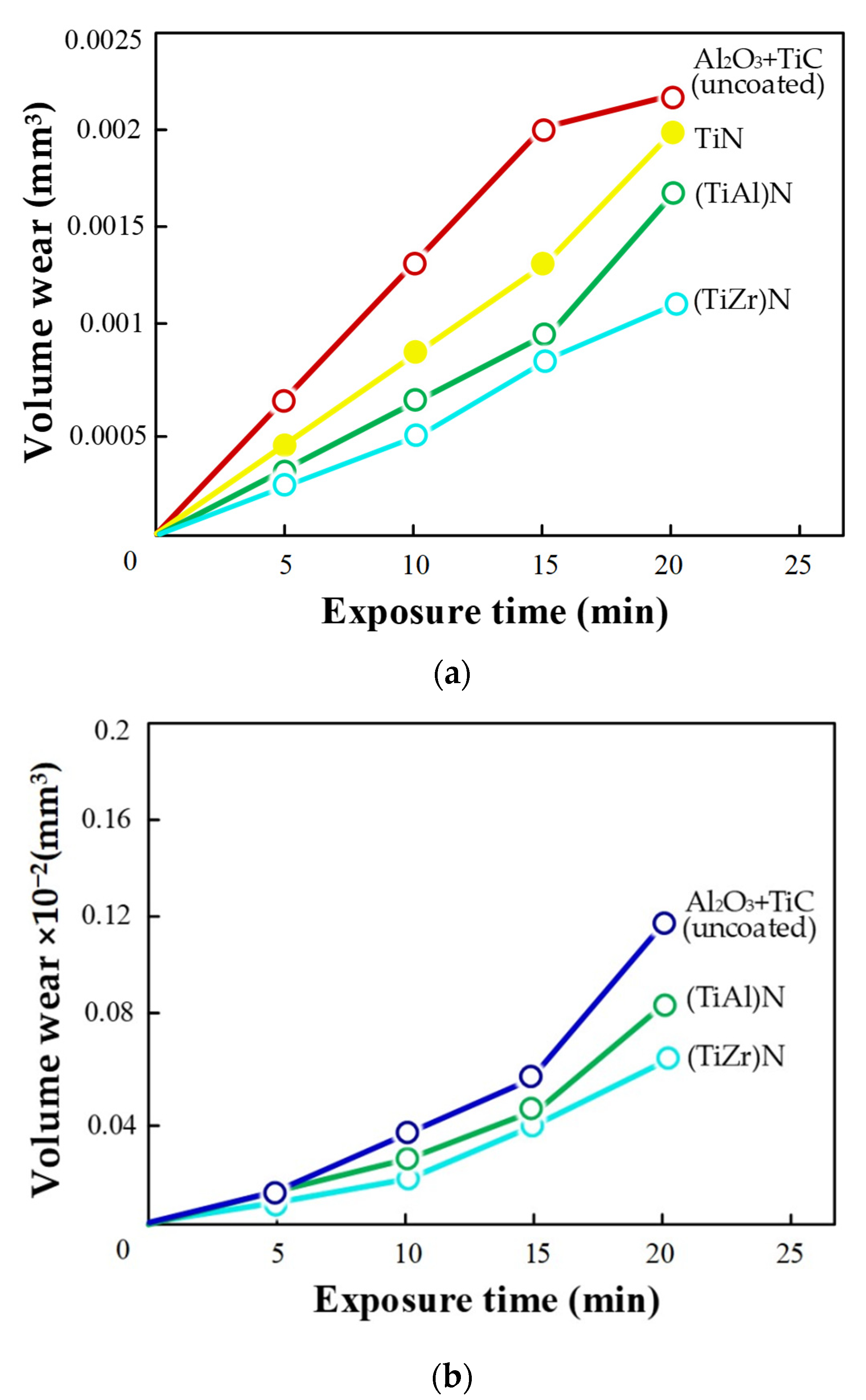
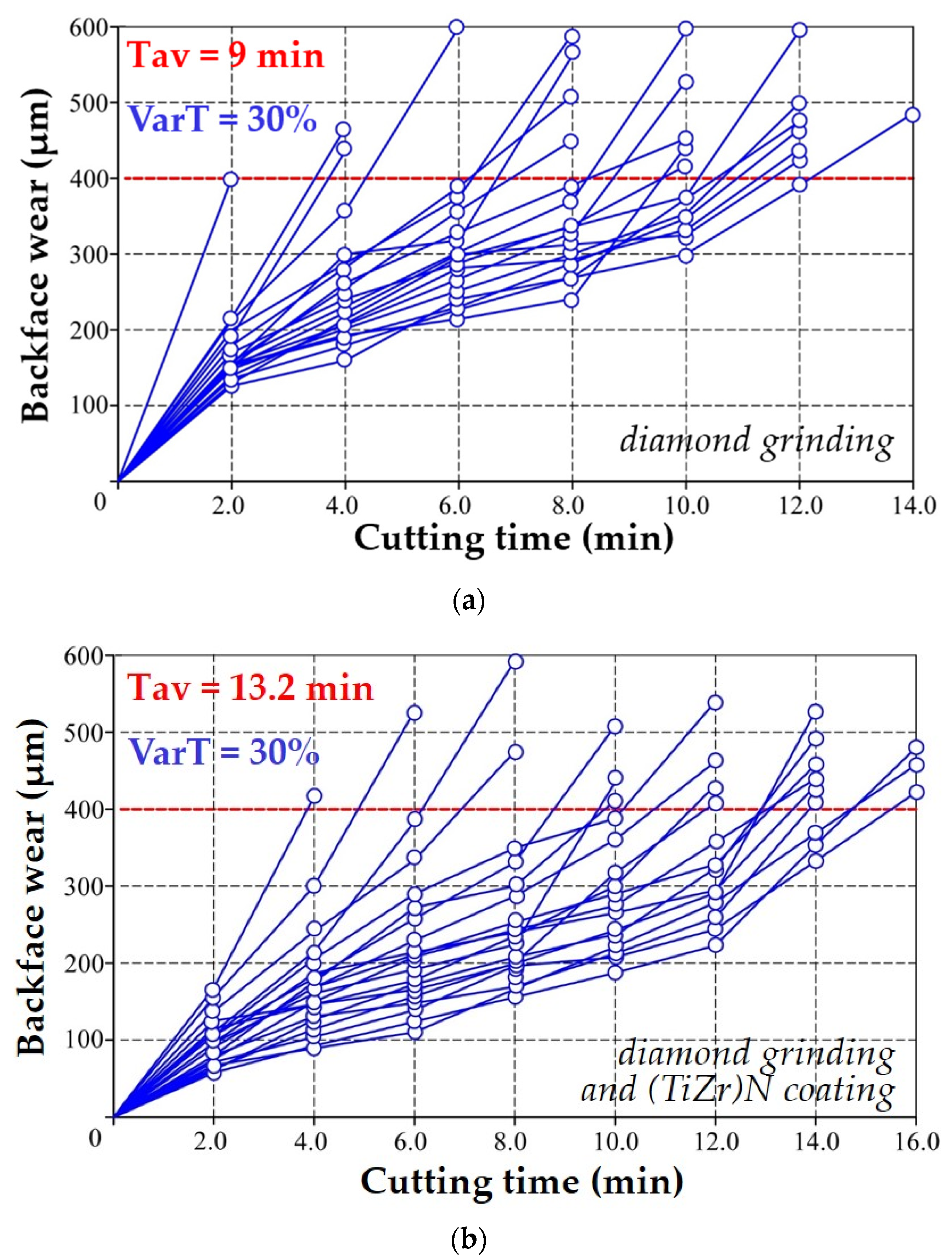
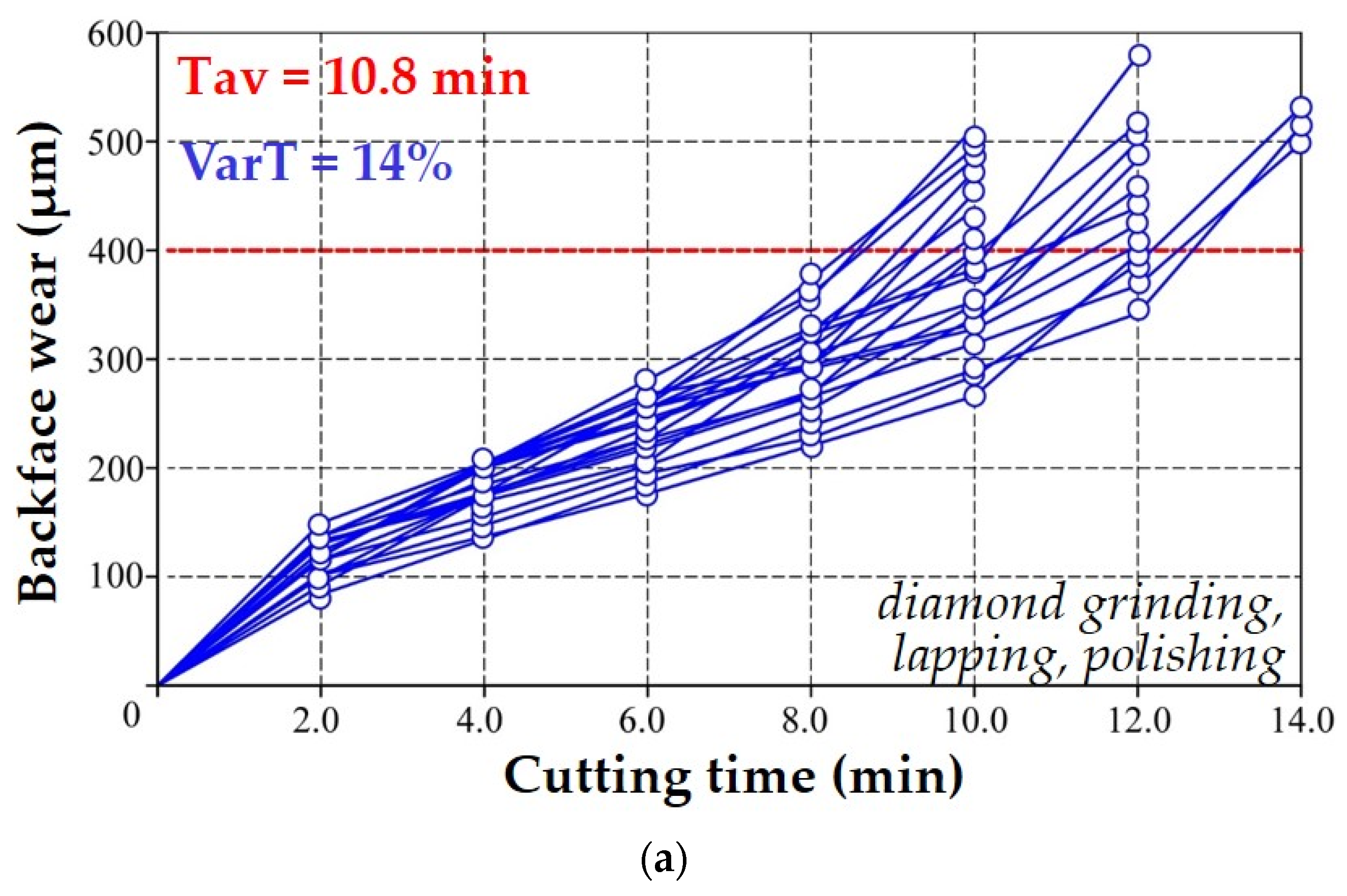
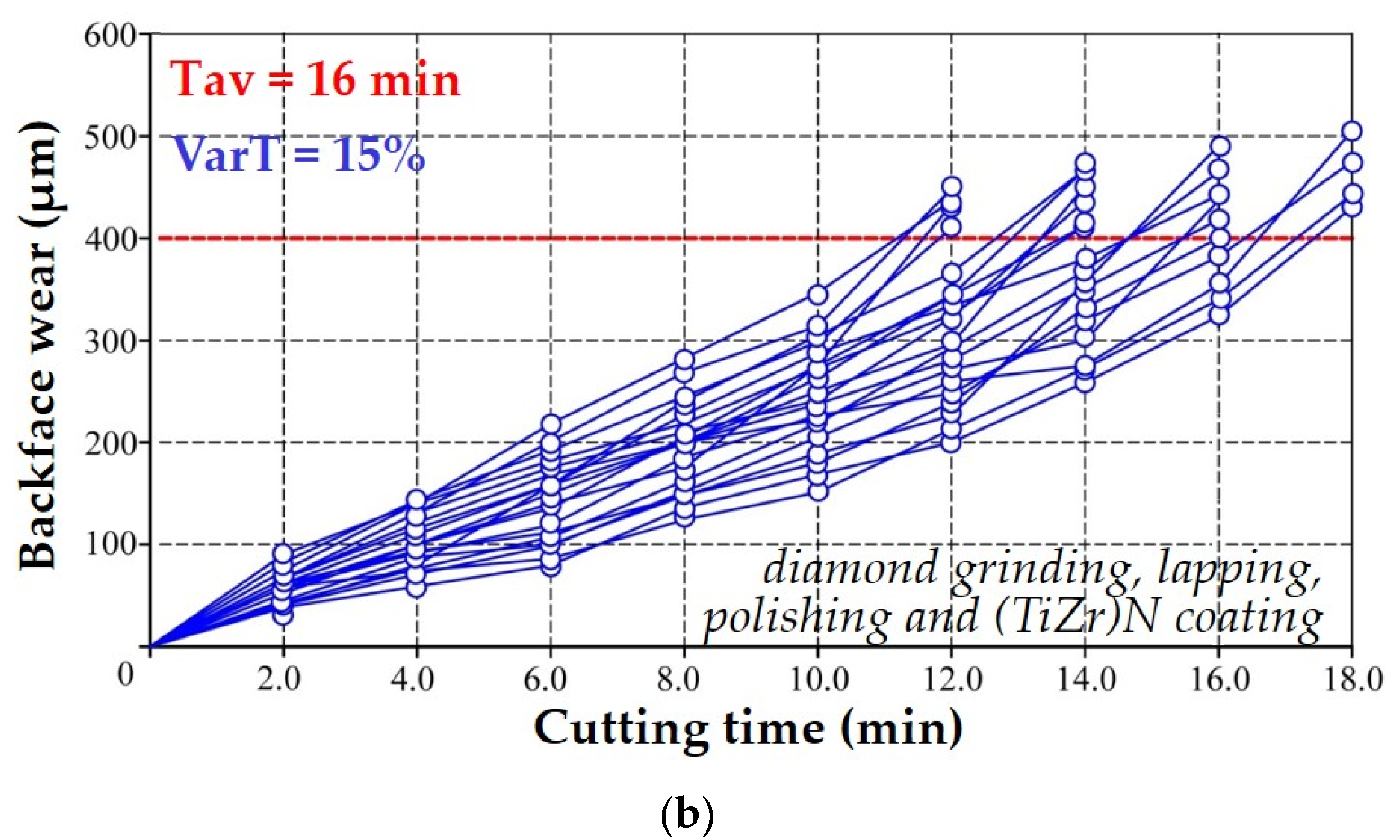

| Element | Fe | Cr | Mn | C | Si | Ni | Cu | S | P |
|---|---|---|---|---|---|---|---|---|---|
| Content (%) | 95.3 | 1.56 | 1.1 | 1.0 | 0.5 | 0.3 | 0.2 | 0.02 | 0.02 |
| Stage of the Process | Technological Modes of the Process | Value of the Modes When Applying Two Options of Coatings | |
|---|---|---|---|
| (TiZr)N | (TiAl)N | ||
| Purification in gas plasma with argon ions | Arc currents at the cathode, A | 100 | |
| Bias voltage, V | 600…800 | ||
| Argon pressure, Pa | 1.0 × 10−1 | ||
| Purification time, min | 10 | ||
| Metal ion bombardment | Number and material of cathodes | 1 Ti + 1 Zr | 1 Ti + 1 Al |
| Arc currents at the cathode, A | 110 (Ti) | 110 (Ti) | |
| 100 (Zr) | 80 (Al) | ||
| Bias voltage, V | 950 | ||
| Ion bombardment time, min | 8 | ||
| Coating deposition | Number and material of cathodes | 1 Ti + 1 Zr | 1 Ti + 1 Al |
| Arc currents at the cathode, A | 110 (Ti) | 110 (Ti) | |
| 100 (Zr) | 80 (Al) | ||
| Bias voltage, V | 300 | 250 | |
| Reaction gas pressure N2/Ar, Pa | 4.0 × 10−1 | 4.5 × 10−1 | |
| Deposition time (for h = 3.7 μm), min | 50 | 40 | |
| No | Option of Abrasive Treatment of Ceramic Inserts Al2O3+TiC | Average Values of the Characteristics of the Surface Layer | |||
|---|---|---|---|---|---|
| Crack Resistance Kc (MPa·m1/2) | Microhardness HV (GPa) | Roughness Ra (μm) | Defect Layer Depth Rt (μm) | ||
| 1 | Diamond grinding (I) | 3.68 | 14.82 | 0.3 | 3.32 |
| 2 | Diamond grinding, lapping and polishing (II) | 3.9 | 15.1 | 0.02 | 0.31 |
| No | Composition of the Coating on the Ceramic Insert | Physical and Mechanical Characteristics | |||||
|---|---|---|---|---|---|---|---|
| Nanohardness H (GPa) | Modulus of Elasticity E (GPa) | Index of Plasticity H/E | Friction Coefficient when Heated to 800 °C at a Distance of 200 m | Breaking Load When Assessing Adhesion (H) | |||
| Min Value | Max Value | ||||||
| 1 | Al2O3+TiC after diamond grinding | ||||||
| 1.1 | TiN (industrial) | 24 ± 3 | 305 ± 10 | 0.07 | 0.59 | 1.1 | 28 |
| 1.2 | (TiAl)N | 33 ± 4 | 342 ± 10 | 0.09 | 0.54 | 0.92 | 31 |
| 1.3 | (TiZr)N | 29 ± 3 | 329 ± 12 | 0.08 | 0.42 | 0.78 | 32 |
| 2 | Al2O3+TiC after diamond grinding, lapping and polishing | ||||||
| 2.1 | (TiAl)N | 33 ± 1 | 326 ± 6 | 0.1 | 0.52 | 0.8 | 41 |
| 2.2 | (TiZr)N | 31 ± 1 | 310 ± 4 | 0.1 | 0.4 | 0.65 | 43 |
Publisher’s Note: MDPI stays neutral with regard to jurisdictional claims in published maps and institutional affiliations. |
© 2022 by the authors. Licensee MDPI, Basel, Switzerland. This article is an open access article distributed under the terms and conditions of the Creative Commons Attribution (CC BY) license (https://creativecommons.org/licenses/by/4.0/).
Share and Cite
Volosova, M.A.; Stebulyanin, M.M.; Gurin, V.D.; Melnik, Y.A. Influence of Surface Layer Condition of Al2O3+TiC Ceramic Inserts on Quality of Deposited Coatings and Reliability during Hardened Steel Milling. Coatings 2022, 12, 1801. https://doi.org/10.3390/coatings12121801
Volosova MA, Stebulyanin MM, Gurin VD, Melnik YA. Influence of Surface Layer Condition of Al2O3+TiC Ceramic Inserts on Quality of Deposited Coatings and Reliability during Hardened Steel Milling. Coatings. 2022; 12(12):1801. https://doi.org/10.3390/coatings12121801
Chicago/Turabian StyleVolosova, Marina A., Mikhail M. Stebulyanin, Vladimir D. Gurin, and Yury A. Melnik. 2022. "Influence of Surface Layer Condition of Al2O3+TiC Ceramic Inserts on Quality of Deposited Coatings and Reliability during Hardened Steel Milling" Coatings 12, no. 12: 1801. https://doi.org/10.3390/coatings12121801
APA StyleVolosova, M. A., Stebulyanin, M. M., Gurin, V. D., & Melnik, Y. A. (2022). Influence of Surface Layer Condition of Al2O3+TiC Ceramic Inserts on Quality of Deposited Coatings and Reliability during Hardened Steel Milling. Coatings, 12(12), 1801. https://doi.org/10.3390/coatings12121801








